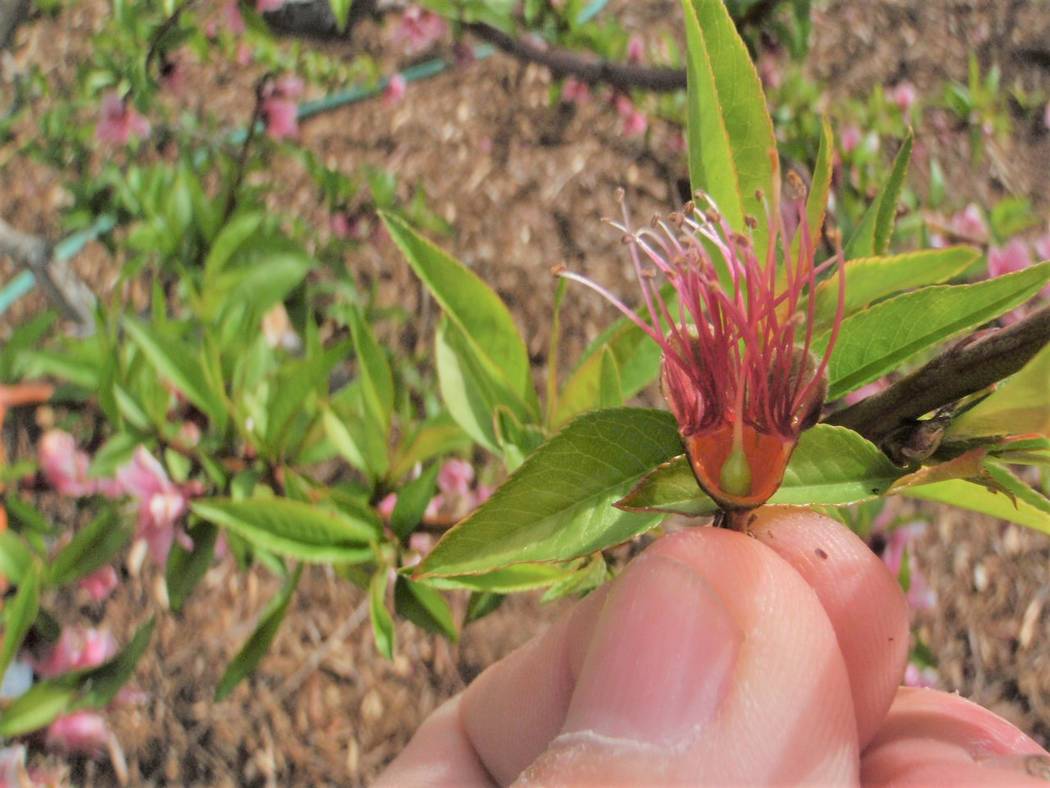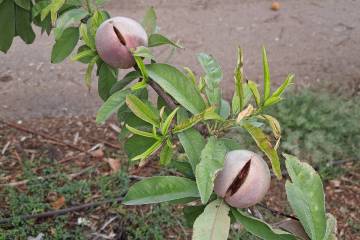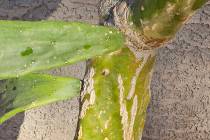Freezing temperatures can cause trees to lose fruit
If you have fruit trees, do me a favor. If you don’t know already, go outside and see if your trees are starting to flower. Many of you will know this already, but some people don’t go outside and look. Then the same people later wonder why their tree didn’t produce any fruit or produced very little fruit.
Some peaches flower early in the spring and some later, and some citrus have open flowers right now. If freezing weather came through your yard, those fruit trees with open or partially opened flowers will lose fruit to the freeze. Some may even lose their flowers. If several freezes come through your backyard a week apart during the month, it’s possible to lose all the fruit because of sequential freezing temperatures.
Last year’s fruit production was much lower than in previous years. That’s because we had three freezing events about a week apart that moved through the Las Vegas Valley in February, including one snow event. This reduced or eliminated fruit production on about two-thirds of the fruit varieties in the valley.
It doesn’t take much to lose the fruit. Open flowers tolerate freezing temperatures to 32 degrees F. If the flowers have finished blooming and there are very small fruit present, this tender fruit can handle 30 or 31 degrees max. The tree might easily handle much lower temperatures, but the flowers and fruit can’t. Fruit production might be lost for that year.
What can you do? Some people wrap Christmas tree lights (old fashioned incandescent types, not the LEDs) and throw a sheet of plastic or a light blanket over the tree to give the flowers a few degrees of added protection. Frost blankets thrown over the trees give them a few extra degrees of protection. This helps if the freezing temperatures are just a couple of degrees too low.
Some varieties of peaches such as Flordaprince, May Pride and others flower around the first of February every single year. Other varieties of peaches flower later and are more reliable producers when there are freezing temperatures in early spring. Planting on the colder sides of a building can delay flowering for a few days to a week.
Q: I don’t really have a question but more of a comment. In St. George, Utah, we get some thin, foil-type insulation from the local box store and put it on the inside wall of the container. This helps keep the soil cooler. If plants are really freeze-tender like some of our succulents, we take them in the garage during the coldest time of the winter.
A: Good advice and a practical solution to containers heating up on the side facing the sun during summer months. Soil overheating can be a common problem for container plants growing outside in the sunlight. Overheating the soil inside the container in full sun can kill over half of the root system of plants in containers. Otherwise, nesting a smaller container inside a larger one so that the wall of the smaller one is shaded will also work.
Q: I watered my plants Saturday and dark spots were growing on my prickly pear cactus wherever there are spines. I’m concerned it’s diseased. It wasn’t there are three days ago. Should I cut this down to where I don’t see any of this?
A: I don’t think this is a fungus disease. It is more likely to be damage from freezing temperatures or damage from insects feeding, such as cochineal scale. If you didn’t see any white fluffy stuff at these locations in the past then it’s more likely to be damage from cold.
These cacti are traditionally called opuntia, but there are other names like nopal cactus, bunny ears, beavertail cactus, prickly pear cactus, etc. Opuntia cacti are native to the Americas. There are winter-tender varieties from the warm climates of Central America as well as extremely cold tolerant types from the Mojave Desert climate. Those opuntias traditionally used for food in Central America are oftentimes called “nopal cactus,” but they are an opuntia.
Notice the damage, or dark areas, are around what we call the areoles or spines. The nopal cactus is tender to freezing temperatures because it comes from the warmer Sonoran Desert areas of Mexico. We had a freeze that came through the Las Vegas Valley in mid-November along with freezing temperatures this January. If the temperature was low enough and the cactus originated from warmer desert climates, it’s possible there was some freeze damage to the plant. I oftentimes see freeze damage at the areoles when it does occur.
What to do? If you think this cactus might be sensitive to cold temperatures, then never fertilize it after July 1. Start to withhold water from it in about August. If it’s on an automatic timer, then consider hand watering it instead. Giving it plenty of water into the fall months and winter months encourages freezing damage.
I wouldn’t do anything. If it’s in opuntia from warm climates, then all you can do is cover it during cold weather and hope for the best. If there was cochineal scale on it, the white fluffys, then keep the pads hosed off with a high-pressure nozzle during the summer months.
Q: I constructed some raised beds for vegetable gardening about five years ago and filled them with a soil compost mix. I put this soil mix in it and had wonderful success. I’m not sure how to amend it now.
A: In the future, don’t let it go five years before adding compost to the raised beds. Add compost to the raised bed about every other year. Even if you add fertilizer to these raised beds, the plants will have problems with growth after year three.
After year three, you will notice they are not growing as rapidly as before and are not as dark green. To get the same kind of growth and health you had in previous years requires more and more fertilizer. In fact, the nutrient content of your vegetables will be lower if you are not amending the soil regularly with compost.
Most commercial soil mixes in the desert are a mixture of sand and compost. The compost in the soil mix breaks down or disappears each year at a rate of about 30 percent the first year, 20 percent the second year, etc. With our high desert temperatures, it’s faster than that. By the third year you start to see sand in the mix because the compost is over half gone.
A soil mix that contains enough compost should be dark brown. The smell should be earthy. If there’s an adequate amount of compost in the soil mix, that compost should last about two years before it needs to be added again. Fruit trees, lawns and many ornamental trees and shrubs don’t need the same rich soil that many vegetables need, so they don’t need soil amendments as often.
Add a 1-inch layer of compost to raised beds every other year and mix it with the existing soil. One 4-by-8 raised bed requires about 3 cubic feet of compost applied to its surface every two years. This compost should be dug or rototilled as deeply as possible. When you’re finished, a garden trowel should push into the soil easily to allow for good vegetable and herb growth.
This addition of compost addresses the soil structural needs of vegetables so roots can grow, explore and extract the nutrients they need. So, what about the nutrients? If the compost is rich to begin with, then both jobs (improvement of soil structure and addition of plant nutrients) are done. No additional fertilizer is needed for several months.
But what if the compost is not rich to begin with? Then add your favorite fertilizer at planting time, whether it’s fish emulsion, guano or conventional mineral fertilizers. These fertilizers will all promote the growth of your vegetables, but only additions of compost improve the soil’s structure.
How do you know if your vegetables need fertilizer or not? Look at them. If they are growing vigorously and dark green, don’t give them any fertilizer. If the green in their leaves is not dark green, consider adding fertilizer high in nitrogen.
I should mention phosphorus fertilizers. Very rich compost is frequently high in phosphorus, so additions of phosphorus fertilizers are not usually needed. However, if you use a good compost that isn’t rich in nutrients, then a phosphorus fertilizer should be added at planting time.
Bob Morris is a horticulture expert and professor emeritus of the University of Nevada, Las Vegas. Visit his blog at xtremehorticulture.blogspot.com. Send questions to Extremehort@aol.com.





























